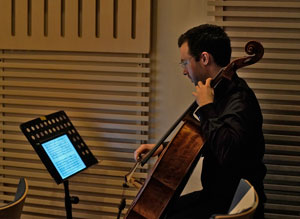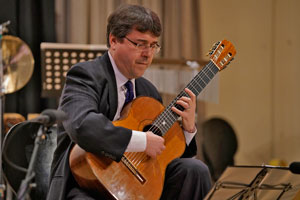
Festival 2018
New York City at Scandinavia House/Victor Borge Hall
58 Park Avenue, New York (between 37th and 38th Streets)
February 17th, 8pm: The Works of Tokuhide Niimi
February 18th, 5:30pm: Diversification of Japanese Contemporary Music
For the third year of the Artist Residency Program, Music From Japan invited composer Tokuhide Niimi and musicologist Toshie Kakinuma from Japan to participate in a series of educational events and concerts in New York.
The Works of Tokuhide Niimi
Musicologist Toshie Kakinuma gave a compelling lecture called “Trends in Contemporary Music in Japan after the Osaka Expo in 1970,” preceding the concert. In it, she discussed the history of, and shed light on some of the ideological dissonances within, the field of avant-garde composition in Japan after this momentous occasion. The Expo represented a turning point both for the cultural history of Japan and in the life of Professor Kakinuma.
Following the lecture, Momenta Quartet performed Tokuhide Niimi’s String Quartet No. 2 Asura, composed in 2011. The piece began with a pianissimo flurry of notes, that increased in a slow crescendo. Niimi, who seems to have a penchant for bringing life to simple material through his imaginative thematic development, then introduced a four note chromatic descent. That four note theme would reappear in many forms throughout the piece, which was sometimes manic, sometimes brooding. As it came to a close, the chromatic line was inverted into an ascending one, and just as the work began with a tremulous flurry of notes, it seemed to disperse back into the place from which it came, tapering off into nothingness.
The second section of Concerto for Chorus, Bios, followed. Performed by the C4 vocal ensemble, the work opened with a unison that gradually broke off into dissonances. Like the quartet before it, Bios covered a lot of compositional ground, from ponderous chordal stops to tremulous unisons in the upper register. The text, which drew from Kenji Miyazawa, Ralph Waldo Emerson, and a Latin aphorism, were all delivered in their respective languages. Nonetheless, the meaning of the words—which all contemplated the most penetrating questions of life—seemed to be transmitted through the music itself, for all to know and feel.
The final piece, a piano quintet called shape of the soul, was the world premiere of a commission by Music From Japan. While the piece employed some of the atonal elements of the previous two pieces, it also hinted towards a tonal center and heavily used a mode with a prominent augmented second. The use of two double-reeded instruments (oboe and bassoon) emphasized the references to the Middle East, already made apparent by the frequent use of the augmented second.
After the concert, the first panel included Mr. Niimi, Timothy Brown (the conductor of C4 Vocal Ensemble), John Fleming (the current president of the Music Critics Association of North America) and Barbara Jepson (former president of the Music Critics Association of North America), who moderated the panel. The panelists each voiced their impressions of the program, and asked Mr. Niimi questions about his music. The second panel included American composers Anthony Cheung and Julia Wolfe, and Japanese conductor Yasuaki Itakura; John Fleming and Barbara Jepson remained. The panelists discussed MFJ’s upcoming collaboration with MCANA Institute and two American composers, to take place in July in Japan.
Diversification of Japanese Contemporary Music
The second concert of the weekend opened up with two short piano pieces by composer Ryuichi Sakamoto, arranged by Yuji Takahashi. Sakamoto, who is famed for his remarkable adeptness at writing and playing music across many genres, from the avant-garde to the classically elegant, the two pieces that began the program fell into the latter camp. Both River and Grasshoppers, smartly interpreted by Aaron Wunsch on piano, gleamed with clarity and compositional precision, but at the same time did not seem like a repetition of the past, through certain rhythmic eccentricities. Melodia for bass clarinet, by Makiko Nishikaze and performed by Marianne Gythfeldt, followed. Ms. Nishikaze is interested in the spacialization of sound, and somehow, even though the sound was coming from a single performer positioned at the center of the stage, the long tones and staccato notes seemed to emanate from the corners of the room itself. The wa-go-n an ancient koto indigenous to Japan, was the featured instrument in the only traditional piece on the program, Shizuuta, which was transcribed by Mayu Masuda from a manuscript compiled over one thousand years ago. Kayoko Nakagawa performed the piece, which consisted of mostly broken chords complementing the vocal line homophonically. The next piece, shima-zima (Islands), by Makiko Nishikaze did involve an actual spacialization of the sound, with the six performers walking about the auditorium while playing. Like the collection of islands that make up Japan, in shima-zima each performer simultaneously existed as a unique entity and came together to perform as a musical whole. The performance of the piece was the world premiere of a MFJ commission.
After the intermission, Kayoko Nakagawa returned to the stage with the wa-go-n to perform Mayu Masuda’s new work, Narrating Function IV—Rain Rain, another MFJ commission and world premiere. Unlike Shizuuta, the voice and wa-go-n seemed to act more in counterpoint. Dharani, a work for guitar and voice by Yoshihiko Shimizu and performed by Oren Fader was a slow meditation on a single note interspersed with flourishes and microtonal chords on the guitar, and grace notes and glissandi in the voice. The concert closed with HIka Runners High + a playful piece by Noriko Koide. Each of the seven performers also held a music box, with a melody written by Koide. The work, for flute, clarinet, percussion, guitar, piano, and cello, heavily employed chromatic scale runs, glissandi and repetitive machine like rhythms. It was conducted by esteemed Japanese conductor Yasuaki Itakura.
Before the post-concert panel began, there was a demonstration on the wa-go-n. As Mayu Masuda explained different features of the instrument, Kayoko Nakagawa demonstrated, finally performing a short piece. A forum including several of the composers, Stephanie Griffin (Momenta Quartet), John Fleming, and musicologist Toshie Kakinuma, followed.
The Mitsubishi UFJ Trust Foundation for the Arts
![]()

The Asahi Shimbun Foundation
© Music From Japan, Inc.






















